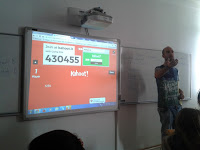Durante este curso
los alumnos de 1º de Bachillerato B del Instituto Francisco Salzillo han
descubierto una nueva herramienta que ha facilitado el proceso de recopilación,
tratamiento y presentación de la información: Smore.
Pero, vamos por partes: ¿Qué es Smore y para qué sirve?
Es una de las herramientas que ofrece la web 2.0 para publicar contenido en forma de página web. Para los docentes, es una herramienta con grandes posibilidades en el aula, es sencilla de utilizar y con un resultado visualmente estupendo. Smore es una herramienta gratuita, solo es necesario registrase para comenzar a crear folletos y páginas web. Es muy práctica para presentar trabajos de clase sea cual sea nuestra materia. Los trabajos se comparten fácilmente en la red gracias a la URL y el código de embebido.
Las ventajas que ofrece son muchas:
·
Es muy fácil de usar porque ofrece unos iconos muy claros y muy
intuitivos.
·
Ofrece la posibilidad de insertar todo tipo de archivos
multimedia (audios, vídeos, gráficos, etc.)
·
Ofrece plantillas prediseñadas o la posibilidad de crear tu
propia plantilla de acuerdo con el objetivo que se persiga ya que permite hacer
folletos, anuncios, revistas digitales, etc.
·
El resultado es muy atractivo.
·
Es una herramienta gratuita aunque también tiene una versión más
completa de pago
Este
es el aspecto que presenta en su inicio:
Utilidades didácticas:
§
Podemos utilizar Smore como cuaderno
virtual para que nuestros alumnos presenten trabajos durante el curso.
§ Crear
trabajos con contenido multimedia: Álbumes de fotos, recopilación
de reportajes en vídeo, comentarios de textos, audiciones musicales, etc.
§ Crear
revistas digitales con los trabajos de los alumnos. Publicar anuncios de eventos del centro, carteles virtuales sobre
actividades y salidas didácticas, etc.
§
Publicaciones de unidades didácticas,
planteamiento de trabajos, propuestas de actividades, explicaciones de tareas,
tutoriales, etc.
Los alumnos este curso lo han usado sobre todo como
soporte para las exposiciones orales sobre temas de literatura y, la verdad, el
resultado ha sido muy satisfactorio. Desde que han descubierto esta herramienta
la han utilizado en otras asignaturas con mucho éxito.
Aquí os dejo algunos ejemplos:
https://www.smore.com/q93he Aquí está el
enlace de un trabajo muy bueno que han hecho: Miriam Lorente, Sara Martínez y
Laura Martínez.
https://www.smore.com/eyfbh y este otro
realizado por Leopoldo Santiago,
José Carlos Ruiz y
Lara Buendía.
Nota: Los murales
se pueden embeber en el blog. Una vez pinches en el enlace tienes el código de
embeber.
Dª Dolores Martínez
Profesora de Lengua castellana y Literatura
IES Francisco Salzillo



